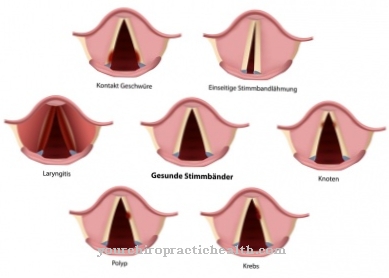Osgood-Schlatter disease is a disorder of ossification (ossification process of cartilaginous structures) in the knee area, which primarily affects young people between nine and fifteen years of age, especially in connection with growth spurts. With a ratio of 3: 1 to 7: 1, boys are more often affected by Osgood-Schlatter than girls.
What is Osgood-Schlatter?

© barks - stock.adobe.com
As Osgood-Schlatter or. Osgood-Schlatter disease a comparatively common aseptic (non-infectious) osteochondrosis of the tibial tuberosity is called, which forms the patellar tendon attachment (shin roughness) as a rough bone process of the anterior tibial edge.
The disturbed ossification can also lead to detached ossicles (small bone segments) when the knee is overloaded, which can subsequently die off (osteonecrosis). As a result of the irritation of the patellar tendon, Osgood-Schlatter initially manifests itself in the form of pain in the area of the roughness of the shin caused by movement and pressure.
Furthermore, the disease can cause pronounced swellings, which lead to pronounced pain when tension is applied to the patellar tendon. At an advanced stage, Osgood-Schlatter's disease can cause protrusions in the affected knee area, some of which can be displaced.
causes
The exact etiology of the Osgood-Schlatter disease is still unclear. It is assumed that aseptic osteochondrosis is caused by overloading the affected knee area.
The overload arises from a discrepancy between the load capacity and the actual load on the cartilaginous core of the tibial tuberosity due to micro-injuries caused by training or being overweight. The discrepancy in turn leads to a disturbed ossification of the cartilage core as well as an impaired fusion of the same with the adjacent shin bone.
The hormonal change during puberty can also result in reduced loading capacity of the tibia (shin) and thus unevenly distributed stress in the knee as well as increased patellar tendon tension. It is also assumed that locally restricted circulatory disorders can cause an Osgood Schlatter.
Symptoms & Signs
Osgood-Schlatter's disease is primarily characterized by pain that occurs primarily below the kneecap and at the upper end of the tibia. This pain is even worse when you exercise. Kneeling, stretching the leg, jerky kicking movements and so on are sometimes severely restricted. Above all, active children between the ages of 11 and 14 are affected.
There is a small rounding that will eventually become visible. This is usually at the lower end of the kneecap and represents a swelling. If pressure is exerted on it, pain also occurs. The rounding can change very significantly. Breaks allow them to quickly shrink and go back inside. Stress - even short-term - make them swell up again and become more sensitive.
Overall, the symptoms in Osgood-Schlatter are very specific. So there is no night-time pain or heat development. The first pain in Osgood-Schlatter ailments is usually only felt indirectly through pressure on the patellar tendon. The other pain develops over a certain period of time and can also remain very weak for a long time. The restrictions on extending the knee joint are also an early symptom.
Diagnosis & course
Characteristic symptoms such as load-dependent pain and a pronounced sensitivity to pressure in the typical knee areas give first indications of one Osgood-Schlatter disease.
Within the scope of sonographic and radiological examinations, the loosening of the bony structures and detached ossicles can be used to demonstrate the fusing disorder of the core of the tibial tuberosity with the adjacent bone structures, which is typical for Osgood-Schlatter. In addition, the disease should be differentiated from an iliotibial ligament syndrome (runner's knee) in a differential diagnosis.
If necessary, in ambiguous cases, the diagnosis is confirmed by magnetic resonance imaging and / or scintigraphy, which at the same time enables statements about possible metabolic disorders. If Osgood-Schlatter's disease is diagnosed early and consistently treated, the disease usually has a good prognosis and almost always heals without consequences at the latest after the growth phase has ended.
Complications
With this disease, most of the people affected suffer from bone problems. This leads to a very strong ossification, which has a very negative effect on the quality of life of the person affected. As a rule, children in particular suffer from this, so that the growth and development of the child are significantly delayed by the disease. The disease can also have a very negative effect on adulthood and lead to complications.
The patients suffer from pain, which can mainly occur in the knees. Tensing the muscles is also associated with pain in most cases, so that the children cannot easily participate in sports. There is also severe pain in the legs themselves, which can occur in the form of resting pain even without stress. In many cases, the regions are also swollen or bruised.
Treatment of this disease is carried out without complications with the help of physiotherapy. The complaints can be limited. Shock wave therapy can also help heal. However, it cannot be predicted whether complete healing will occur. However, the life expectancy of the patient is not reduced due to illness.
When should you go to the doctor?
If the knees are sore under strain, especially when exercising and kneeling down, a doctor should be contacted. Osgood-Schlatter needs to be diagnosed quickly so that treatment can be started before any pieces of bone become detached from the shin. Severe pain in the shin area indicates an advanced condition that needs to be clarified immediately. It is best for those affected to talk to their family doctor, who can make an initial suspected diagnosis and, if necessary, call in other specialists. The symptoms usually appear between the ages of nine and fourteen.
Young people and adult extreme athletes are particularly affected. Anyone who belongs to these risk groups should see a doctor immediately with the symptoms mentioned. Osgood-Schlatter can be treated well if it is recognized early. The sick should therefore contact the doctor at the first suspicion. In addition to the family doctor, sports medicine specialists, orthopedists and physiotherapists can also be called in. Depending on the severity, treatment can take place surgically or with pain medication and preventive measures such as rest.
Treatment & Therapy
There a Osgood-Schlatter disease is attributed to an overload, the therapeutic measures are primarily aimed at relieving the affected structures. For this purpose, in the early stages, exercise abstinence through rest, anti-inflammatory pain relievers (anti-inflammatory drugs), cooling and physiotherapy is usually indicated.
Knee or kneecap straps can also help relieve pain. In addition, affected children and young people may be exempted from school sports. If there are more serious changes or a more advanced stage of the disease, immobilization of the knee by a plaster tutor (plaster cast), which restricts the rotation of the knee joint, may be indicated. This plaster tutor is individually adapted to the affected knee in order to avoid pressure on the patella (kneecap) and potential slipping.
In some cases, forearm supports are also recommended to completely relieve the affected knee. As a support, locally applied ointments can be used. A negative heel (heel lowering) of the shoe sole can also help relieve strain on the kneecap. For a short time, extracorporeal shock wave therapy has also been used to accelerate healing, although it has not yet been clarified which factors are responsible for individual therapy success or failure.
In exceptional cases, surgical intervention may be indicated for detached ossicles such as sequesters (dead and demarcated bone tissue), joint mice (free joint bodies) or bone extensions that irritate the ligaments and restrict the mobility of the knee joint. The surgical removal of the ossicle should only be carried out after the growth phase has ended. In addition, children affected by Osgood-Schlatter disease and who are also obese should aim for weight reduction.
You can find your medication here
➔ Medicines for joint painprevention
Since the underlying etiology for a Osgood-Schlatter disease is not yet fully understood, there are no prophylactic measures in relation to the disease. Avoiding obesity and unilateral strain on the muscles that support the knee joint can, however, prevent Osgood-Schlatter or minimize the symptoms.
Aftercare
In most cases, the affected person has only a few and only limited follow-up measures available. Since it is a genetic disease, it usually cannot be completely cured. Therefore, those affected are usually always dependent on medical treatment from a doctor.
If the patient or the parents wish to have children, a genetic test should primarily be carried out to prevent the disease from recurring. The treatment itself can be carried out by means of physiotherapy or physiotherapy. The affected person can also do some of the exercises at home, which may speed up the treatment.
Many of those affected depend on the help and support of their own families in their everyday lives, whereby care and psychological support in particular can have a positive effect on the further course of the disease. In general, a healthy lifestyle should also be pursued, whereby obesity should be avoided. In some cases, this disease reduces the life expectancy of those affected.
Outlook & forecast
Osgood-Schlatter offers a relatively good prognosis. The disease often goes away on its own. Many patients are symptom-free again after six to 18 months. In individual cases, however, Osgood-Schlatter can develop into a chronic disease. In addition, a large proportion of patients suffer from persistent pain when kneeling. If the pain persists for more than one to two years, a radiological examination is recommended. The doctor can make the diagnosis and give the patient a reliable prognosis.
The view from Osgood-Schlatter is good. Mild pain can be treated with medication. In addition, the disease progresses slowly and does not significantly limit those affected in everyday life. The prognosis has to be made by an orthopedic surgeon or an osteopath. To do this, he consults the results of the examination and the findings from the patient interview.
Last but not least, the financial and social status of the patient also determines the prognosis. Costly therapy procedures are not always covered by health insurance companies. All of these factors must be taken into account in the forecast. Due to the lengthy course of the disease, the prognosis must be adjusted at regular intervals to the patient's state of health.
You can do that yourself
At Osgood-Schlatter, a doctor does not necessarily have to be called in. In the case of mild discomfort, it is sufficient to protect the knee and not subject it to any further stress for a while. The pain should subside after a few days to weeks.
If the Osgood-Schlatter does not subside by itself, medical advice is required. The doctor will first recommend that the affected limb be protected and also prescribe pain relievers, anti-inflammatories and other drugs. Patients can relieve the pain by regularly cooling the affected area. Quark compresses and other home remedies may also be used in consultation with the doctor to reduce Osgood-Schlatter.
If these measures have no effect, the doctor must be consulted again. It is possible that the Osgood-Schlatter is due to a serious illness. If the outcome is positive, you can start exercising again after one to two weeks. Physiotherapy and massages contribute to a speedy recovery. Which therapy works best should be worked out with the orthopedic surgeon. If there are repeated complaints, possible causes should be identified and remedied. Often it is enough to warm up the muscles before exercising or to wear different shoes.



.jpg)




















.jpg)



